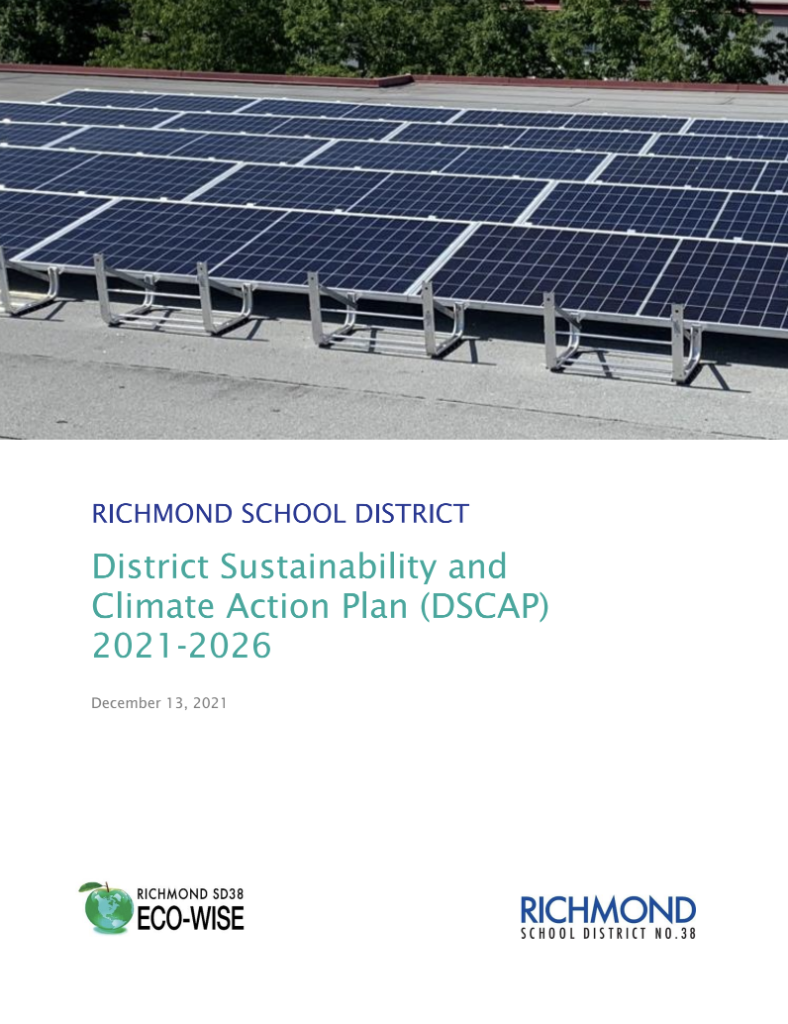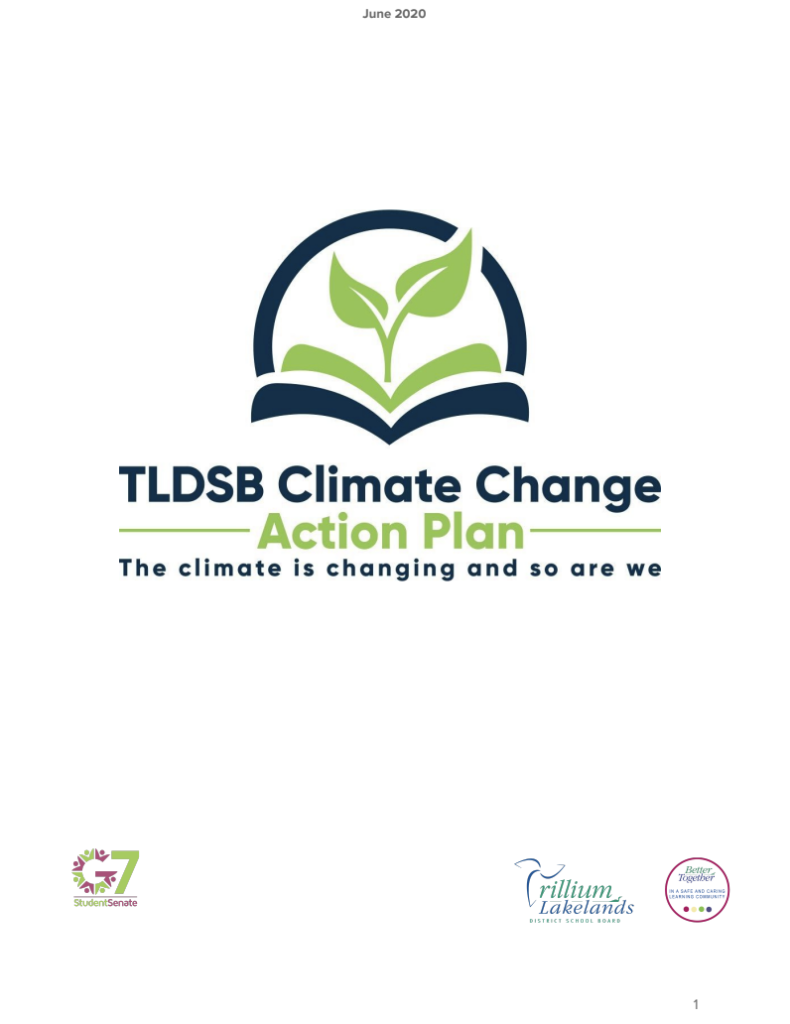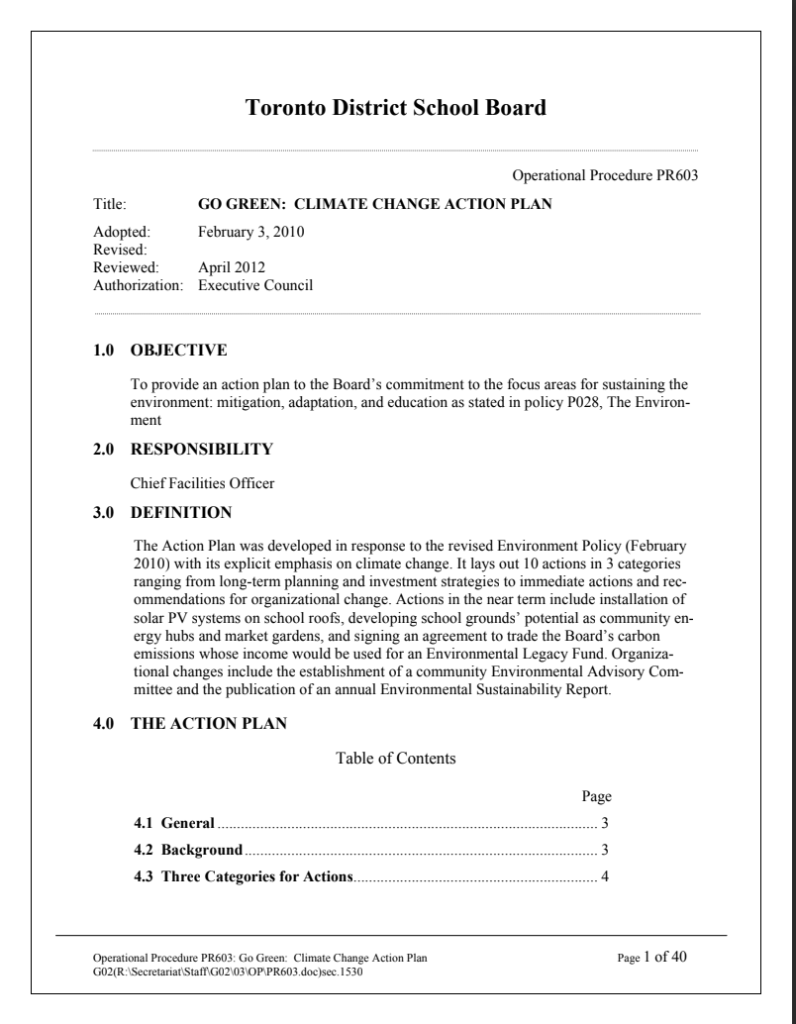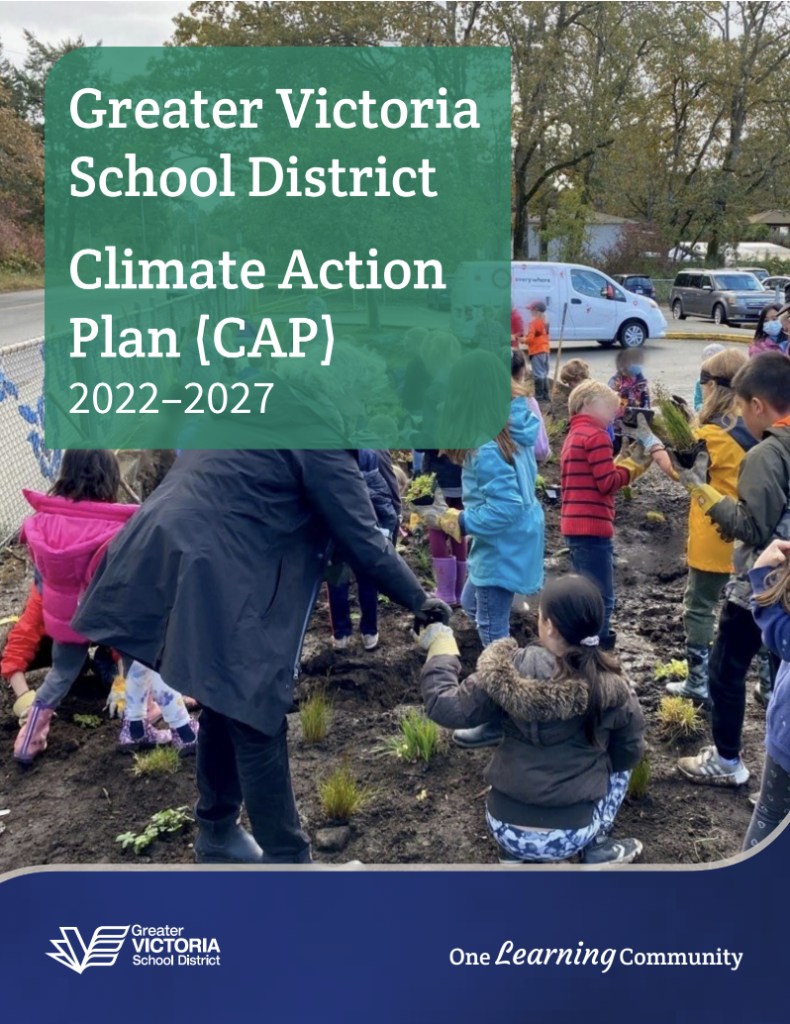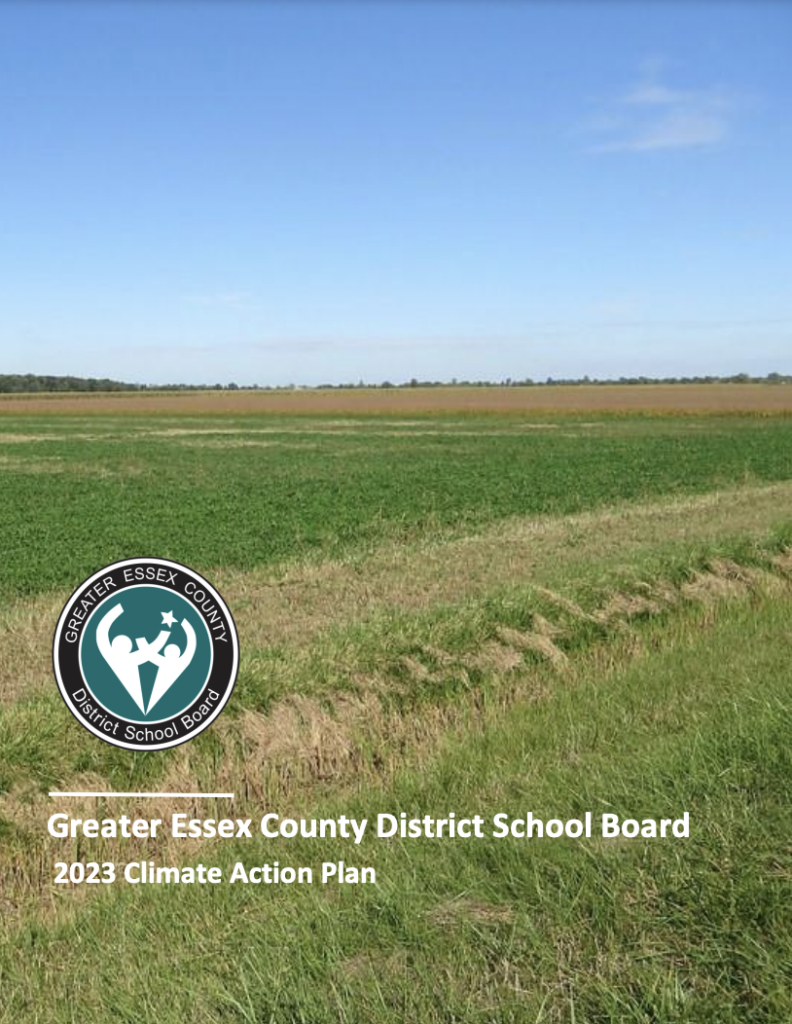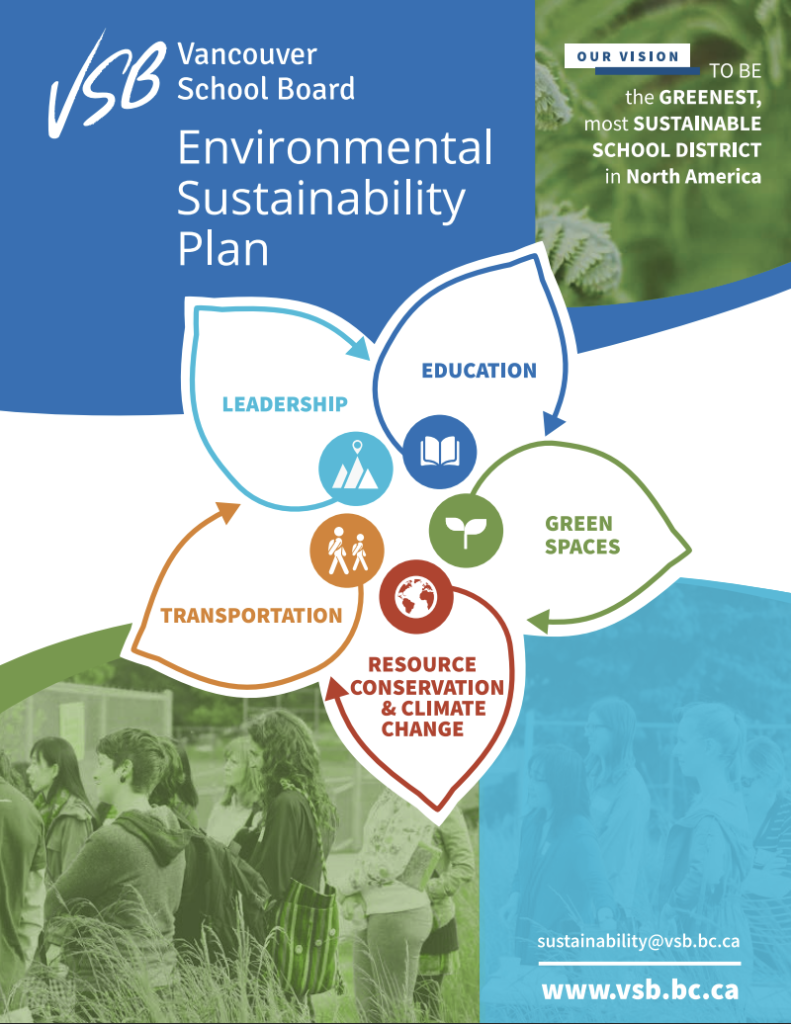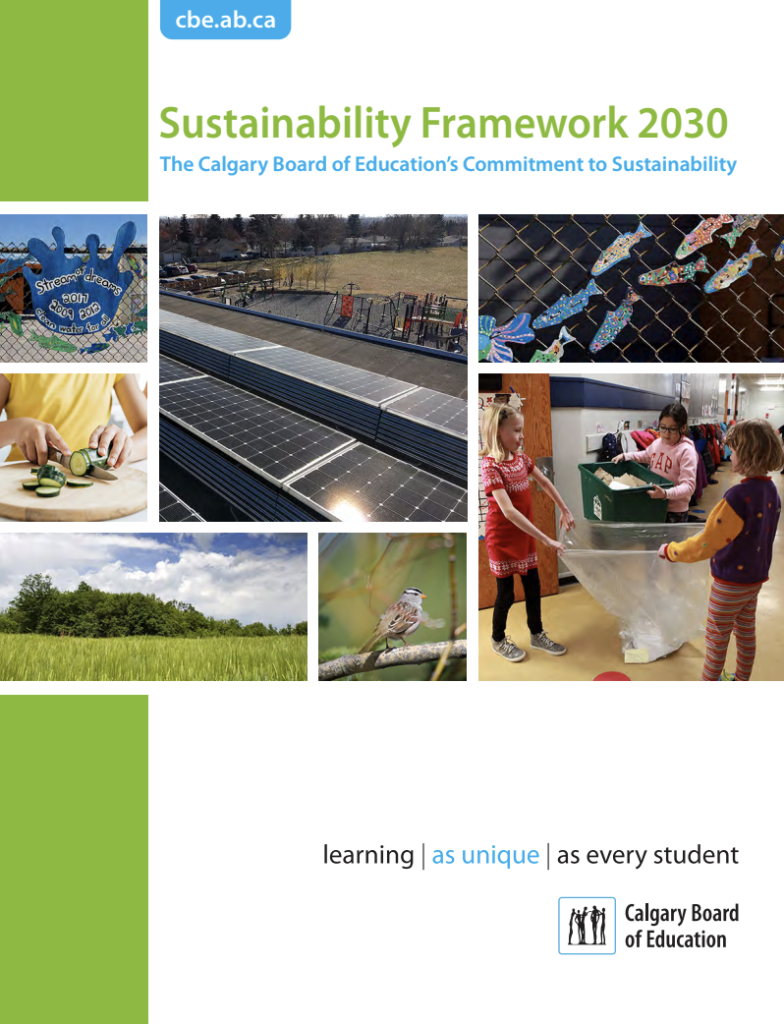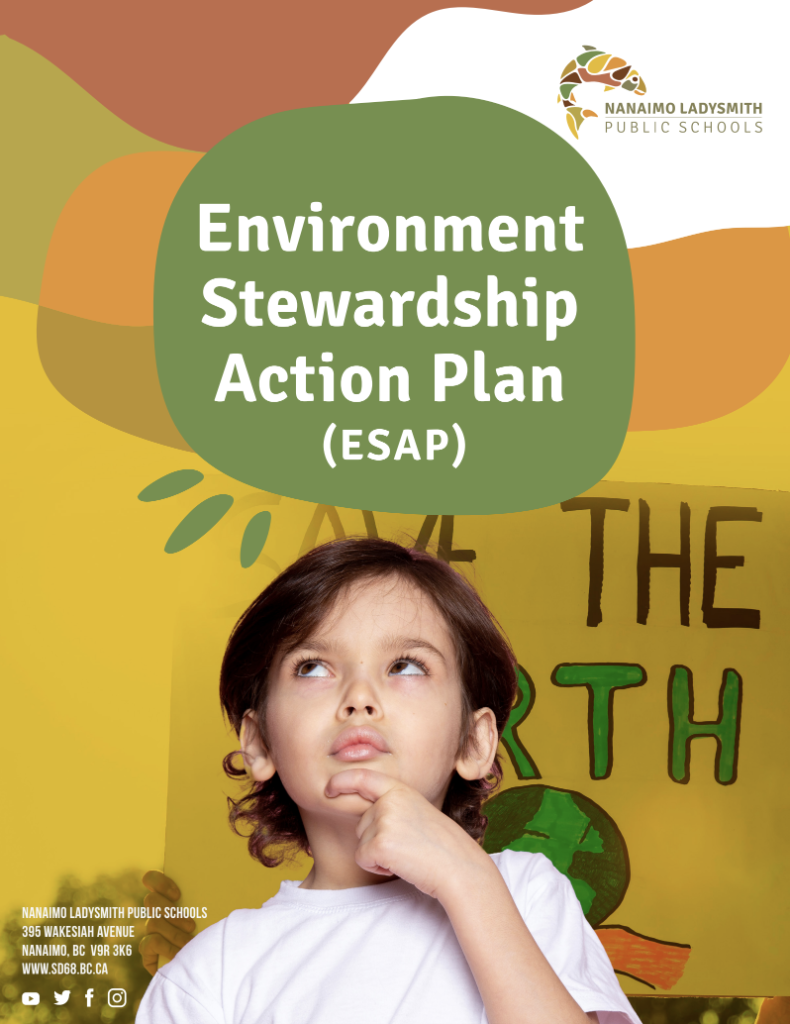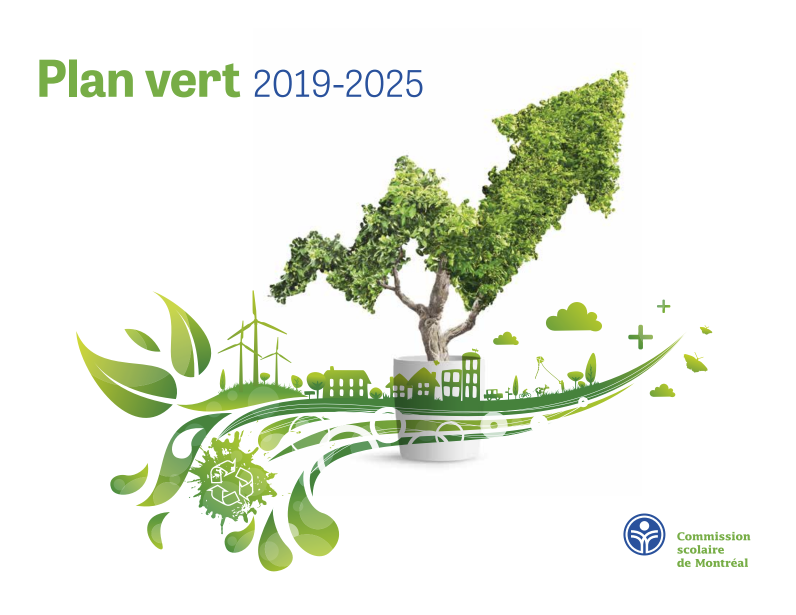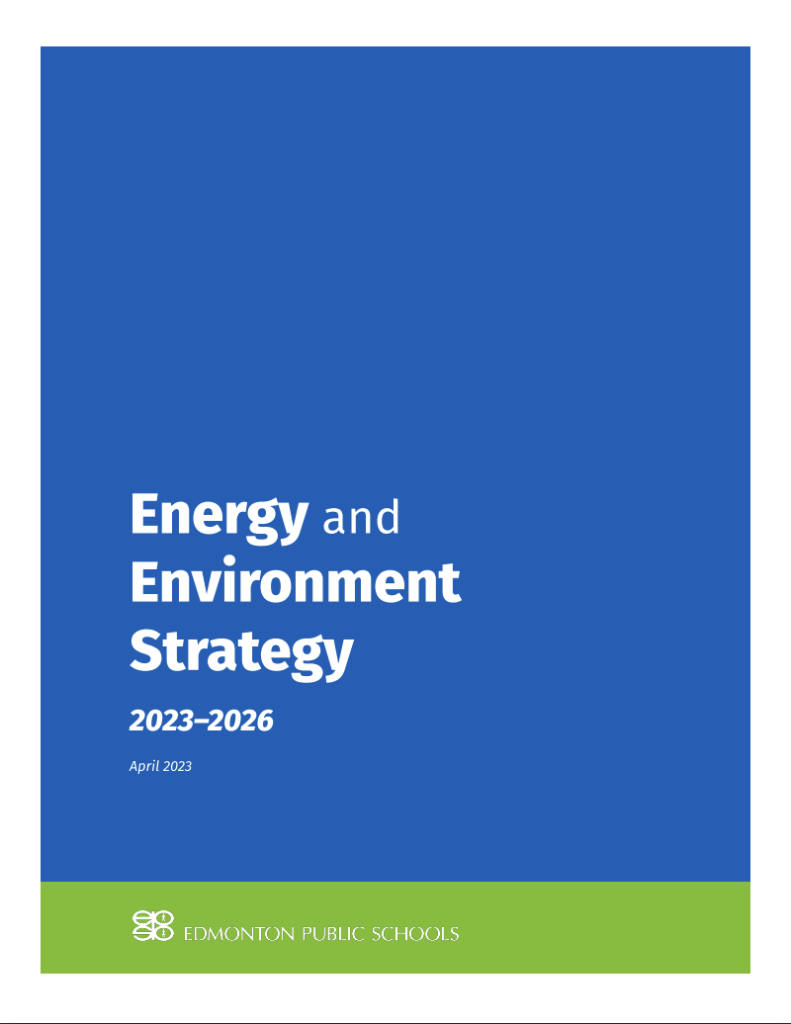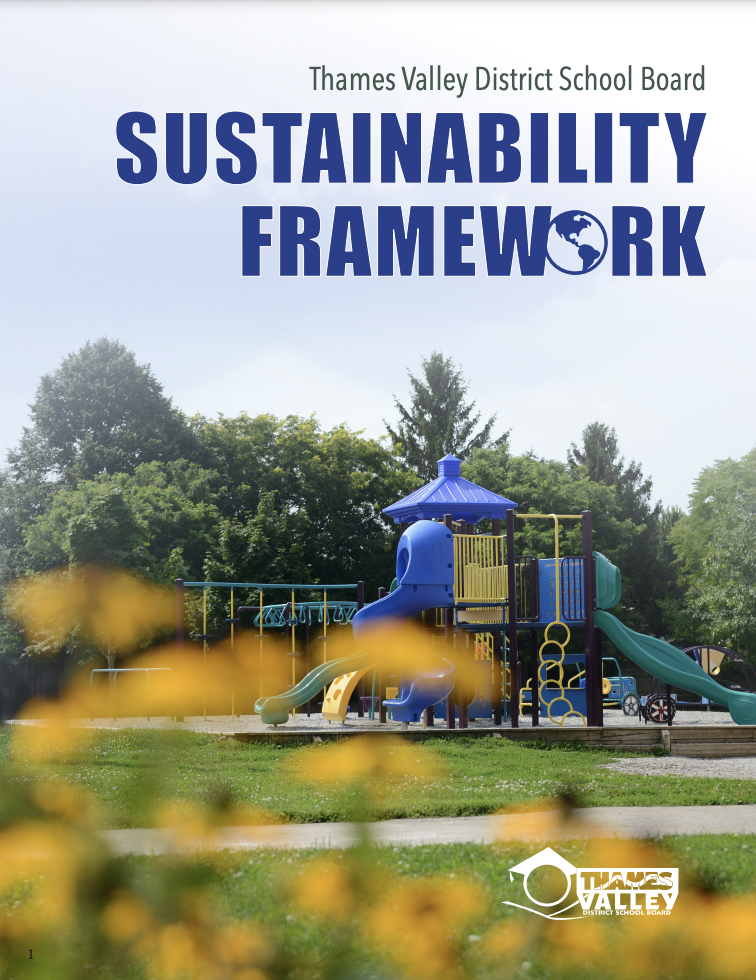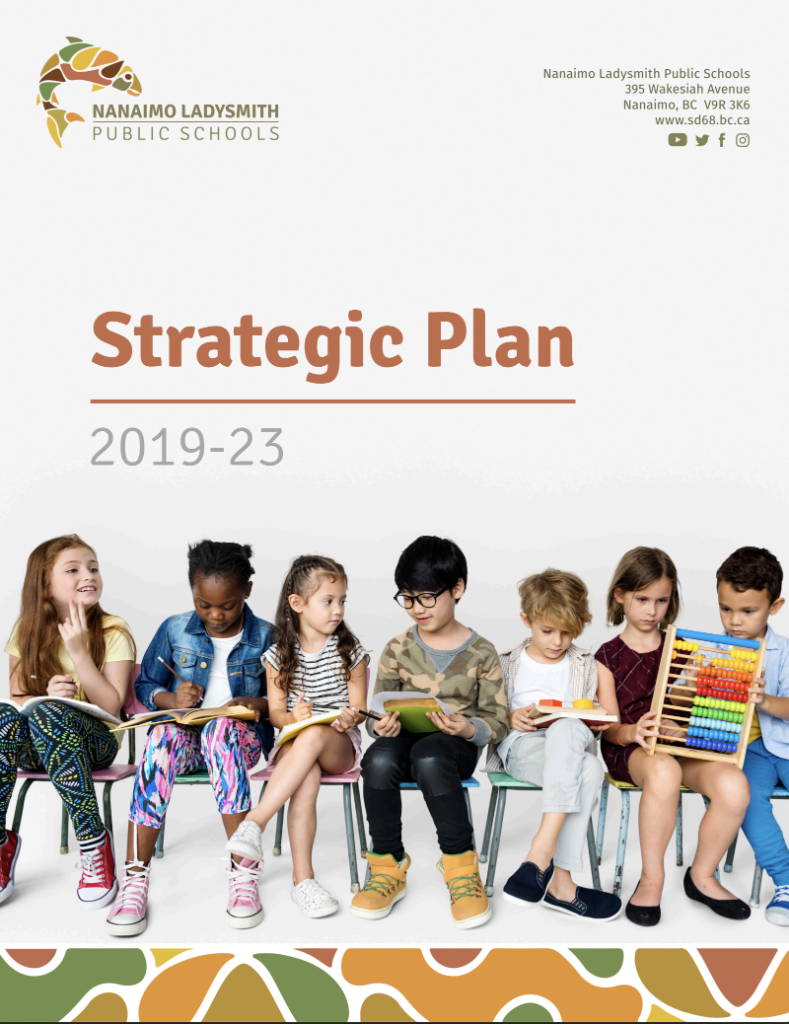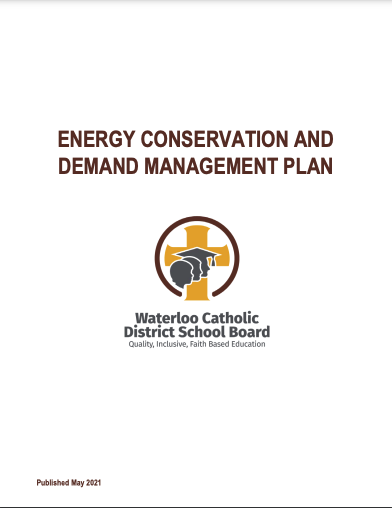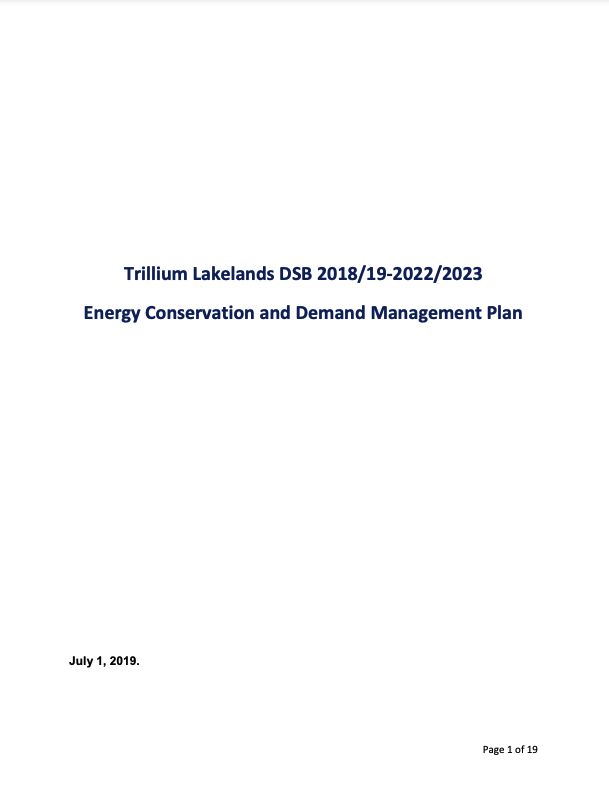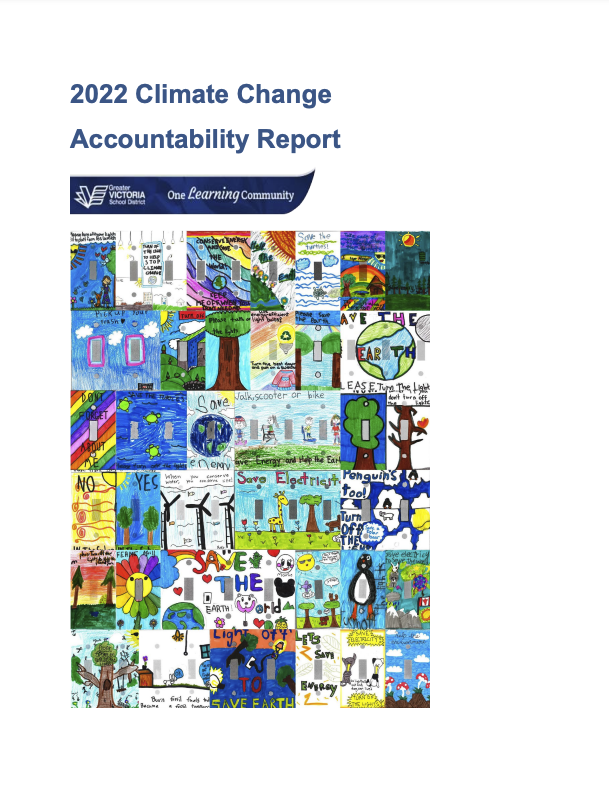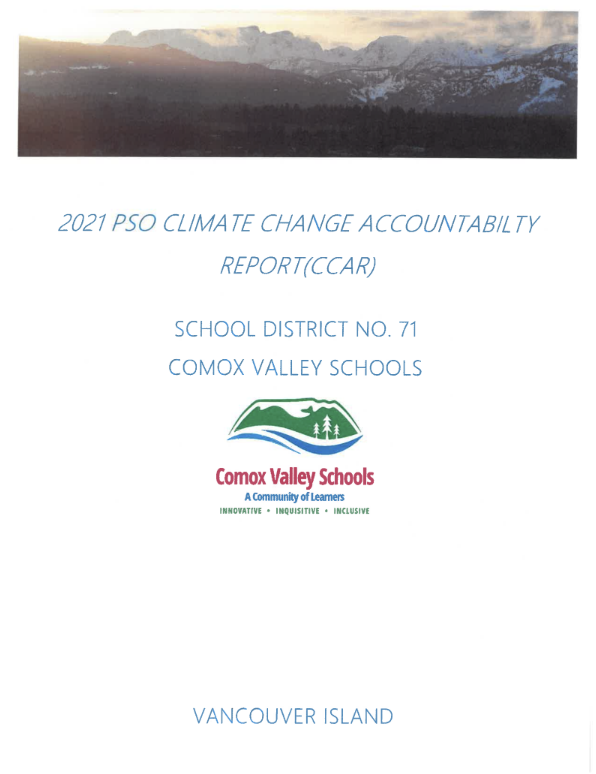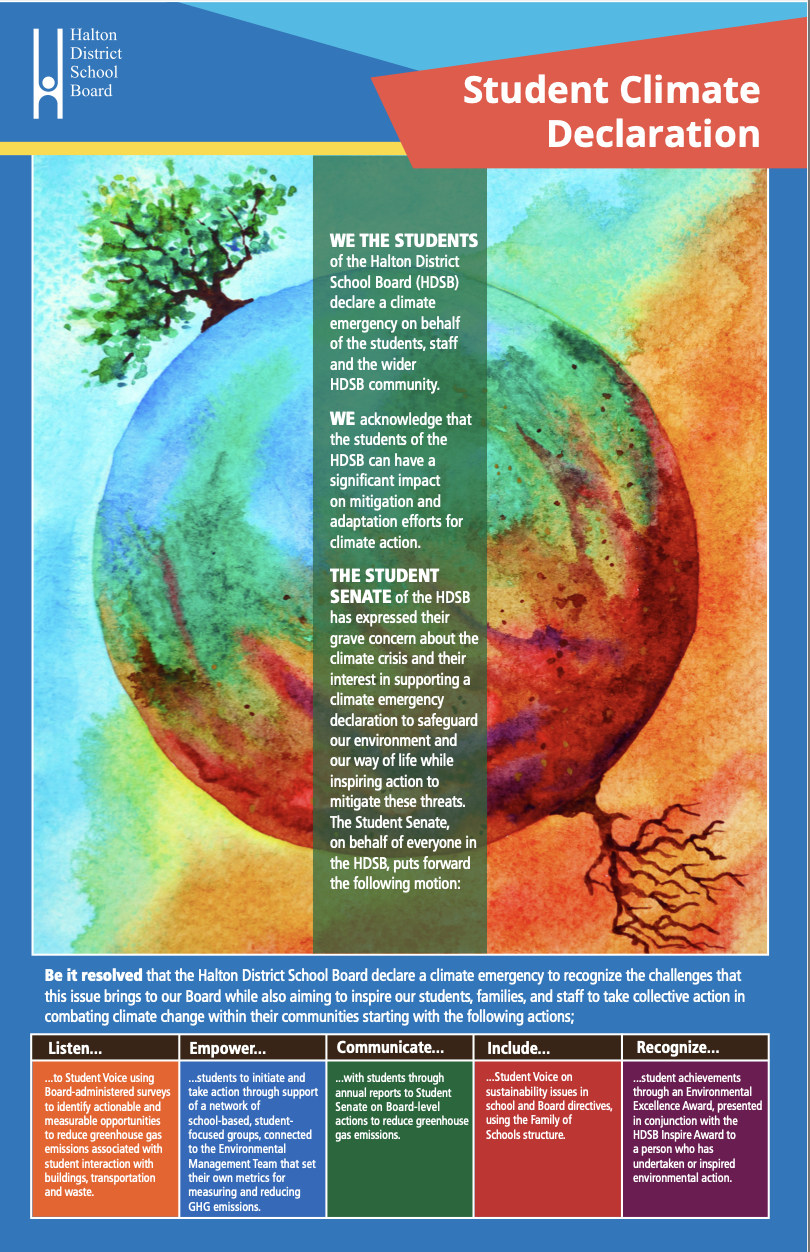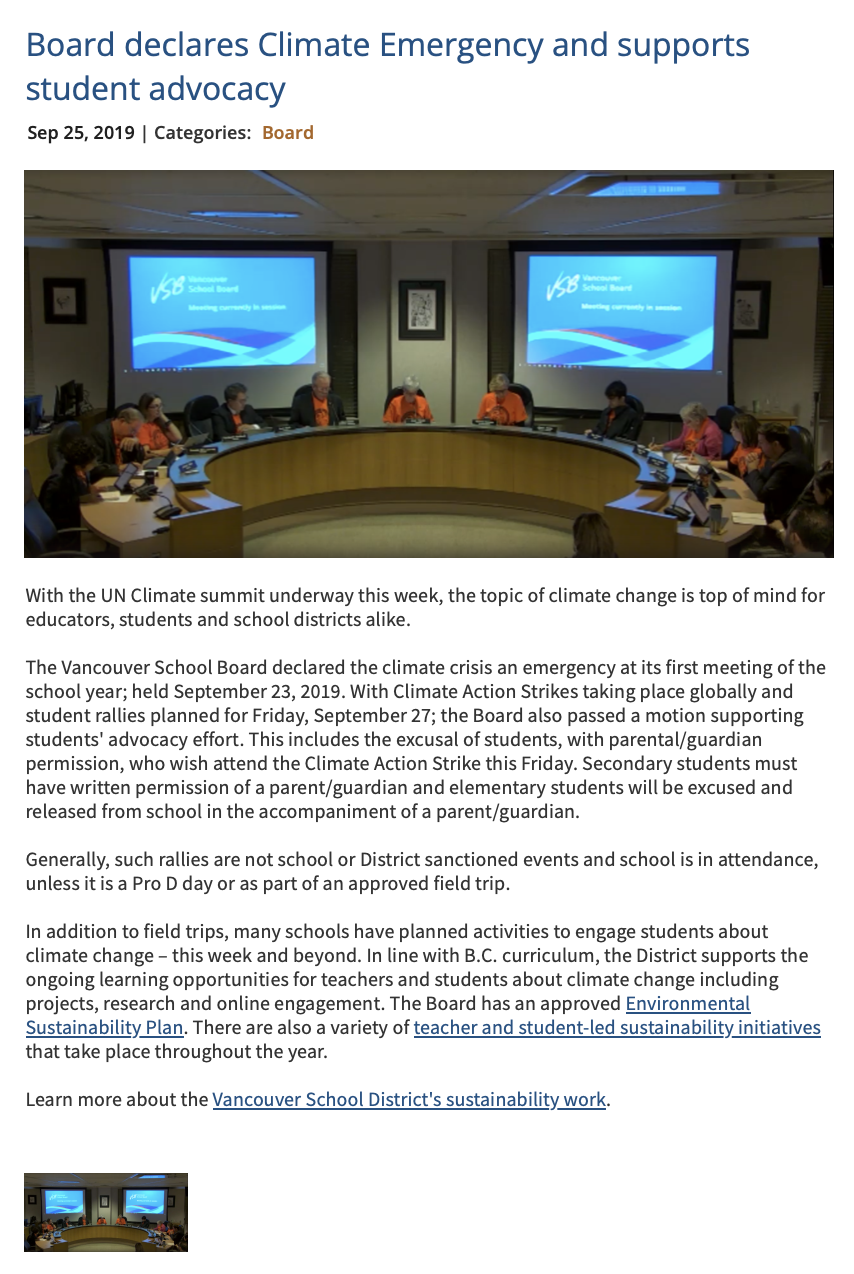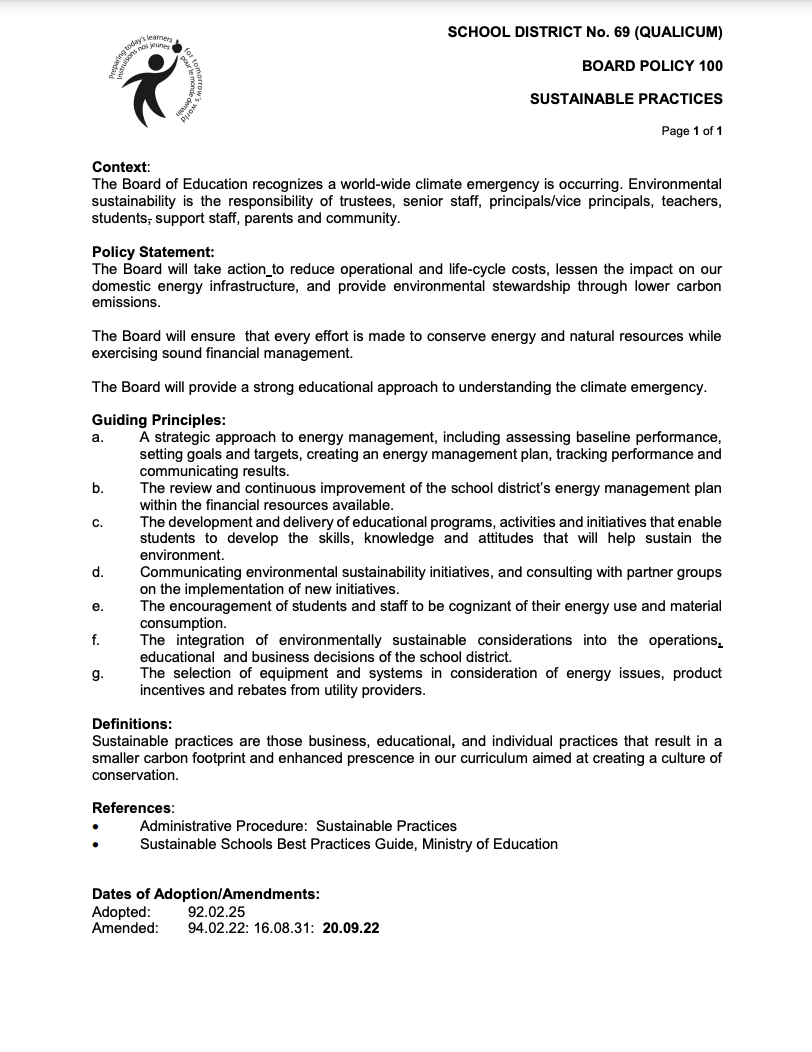School Board Examples
The following is a selection of exemplary plans, policies, and reports. They represent a growing demonstration of climate action leadership within Canadian school boards. Click on the photo of any document to view it.
Climate Action Plans
Climate action planning is crucial for mitigating the impacts of climate change and orienting educational institutions to be prepared for future scenarios. It involves identifying ways to reduce greenhouse gas emissions, as well as adapting to changing climate conditions. With the increasing threat of climate change, the need for comprehensive, effective, and immediate climate action plans is more significant than ever before. To date, four school boards in Canada have published Climate Action Plans. For more information, read Climate Leadership within Canadian School Boards: 2023 Review.
District Sustainability and Climate Action Plan (DSCAP) 2021-2026
Richmond School District, BC
Built off the Richmond School District’s (RSD) Eco-Wise Program, this comprehensive plan provides goals and actions across 9 pillars:
- Leadership
- Learning and Engagement
- Climate Action
- Energy Conservation
- Waste Reduction
- Water Conservation
- Grounds
- Purchasing
- Sustainable Transportation
Informed by consultations with diverse stakeholders, including operations staff, students, parents, and educators, RSD’s Climate Action Plan aims to achieve 50% greenhouse gas emissions reduction by 2030 and net zero operations by 2050.
TLDSB Climate Change Action Plan (2020)
Trillium Lakelands District School Board, ON
Developed and proposed by the G7 Student Senate, which is comprised of one representative from each of the 7 high schools in the board, the TLDSB’s Climate Change Action Plan outlines the following priority areas:
- Education and Commitment
- Mental Health and Student Advocacy
- Technology Considerations
- Waste Management
- Energy Connections
- Food Resilience
- Resource Management
- Carbon-Conscious Transportation
- Creation of Eco-Spaces
- Evaluation
This unique plan provides practical resources for each phase and differentiates system-level and school-based actions. The G7 Student Senate has identified energy audits and conservation goals as system-level action items. Aligning these goals with global agreements would strengthen this Climate Change Action Plan.
Go Green: Climate Change Action Plan (2010) & Beyond
Toronto District School Board, ON
The first of its kind in Canada, the Toronto District School Board’s (TDSB) Go Green: Climate Change Action Plan was adopted in 2010. This detailed plan provides actions within three categories; planning for the long term, quick starts, and organizational change. Since this plan was last reviewed in 2012, the TDSB has migrated their Climate Action Plan to their website and expanded it to include 8 categories:
- Building Climate Resilient Environments
- Conserving Energy
- Encouraging Environmental Behaviour
- Engaging Students
- Improving Biodiversity
- Informing Education Practices
- Promoting Health and Wellbeing
- Reducing Waste
Aiming to achieve Net Zero Carbon Buildings by 2050, TDSB has been a leader in school board climate action for over a decade. The TDSB now requires annual reports on Environment and Climate Change, which can be viewed here.
District Sustainability and Climate Action Plan (2023)
Greater Victoria School District, BC
The Greater Victoria School District’s Climate Action Plan (2022-2027) provides key objectives and actions across 5 pillars:
- Learning, Engagement, Leadership
- Lands and Water Stewardship
- Waste Reduction
- Energy Management
- Sustainable Transportation
Aiming to achieve 50% greenhouse gas emissions reduction by 2030, GVSD has modelled their Climate Action Plan after Richmond School District’s Climate Action Plan, showcasing the power of leading by example and collaborating on our journey to achieving our collective climate goals.
2023 Climate Action Plan
Greater Essex County District School Board, ON
The Greater Essex County District School Board’s (GECDSB) Climate Action Plan (2023) provides targets and timelines across 10 categories:
- GHG Inventory
- Policy
- Existing Buildings
- New Buildings
- Energy Supply
- Waste Management
- Behaviour Change
- Fleet
- Procurement
- Complimentary Opportunities
GECDSB is dedicated to the federal timeline of net zero by 2050.
Sustainability Plans
Sustainability or Environmental Plans represent a diverse set of board strategies to address challenges related to the environment. While the components and depth of a Sustainability Plan varied by school board, they generally serve different purposes and levels of ambition than Climate Action Plans. To date, five school boards in Canada have published Sustainability or Environmental Plans that mention “climate change” or reducing GHG emissions. For more information, read Climate Leadership within Canadian School Boards: 2023 Review.
Environmental Sustainability Plan (2018)
Vancouver School Board, BC
Aligning with their vision to be “the greenest, most sustainable school district in North America”, Vancouver School Board’s (VSB) Environmental Sustainability Plan outlines goals and actions across five theme areas:
- Sustainability in Education
- Green Spaces
- Resource Conservation and Climate Change
- Sustainable Transportation
- Leadership in Sustainability
With a goal to reduce energy consumption and greenhouse gas emissions, VSB’s plan could be improved with measurable, time-bound targets to reduce emissions that align with global agreements.
Sustainability Framework 2030 (2021)
Calgary Board of Education, AB
The Calgary Board of Education’s (CBE) Sustainability Framework 2030 is a concise outline of their 2030 targets relating to sustainability. Informed by diverse community consultation, CBE outlines targets across four themes:
- Learning Excellence
- People Excellence
- Collaborative Partnerships
- Strategic Resourcing.
The CBE aims to achieve 50% greenhouse gas emissions reduction by 2030 and net zero by 2050.
Environment Stewardship Action Plan (2022)
Nanaimo Ladysmith Public Schools, BC
The Nanaimo Ladysmith Public School’s (NLPS) Environment Stewardship Action Plan provides a bulleted list of their targets and actions related to stewardship across five pathways:
- Climate Change Mitigation and Adaptation
- Sustainability
- Responsibility to the Land
- Learning
- Culture/Leadership
The Nanaimo Ladysmith Public Schools aim to reduce their greenhouse gas emissions by 50% below 2010 levels by 2030.
Plan Vert/ Green Plan (2019-2025)
Commission scolaire de Montréal, QC
The Montreal School Board’s Green Plan provides a comprehensive table their actions and targets across a variety of dimensions, including:
- Learning environment
- Ecological environment
- Family and community
- School environment
The Montreal School Board aims to reduce their greenhouse gas emissions by 30% per square meter by 2025 over the 2010 levels.
Energy and Environment Strategy (2023)
Edmonton Public Schools, AB
Edmonton Public Schools’ (EPS) Energy and Environment Strategy outlines their existing sustainability efforts and provides a framework for upcoming initiatives across four key priority areas:
- Environmentally Sustainable Planning
- Environmentally Sustainable Buildings
- Environmentally Sustainable Operations
- Environmentally Sustainable Education
Reflected on their Environmental Sustainability webpage, EPS have committed to carbon reduction targets of five percent by 2025, and 45 percent by 2035 as part of the Corporate Climate Leaders Program through the City of Edmonton.
We Mean Green: Sustainability Strategic Plan (2022)
Burnaby School District, BC
Reflecting the voices and values of the entire community, Burnaby School’s We Mean Green Sustainability Strategic Plan concisely lists objectives and actions around three main goals:
- Support meaningful and innovative educational practices in the curricular areas of sustainability
- Include Indigenous Knowledge as the foundation to understanding and leading sustainable practices
- Reduce the District’s environmental impact in the areas of energy, paper, waste, and procurement
With a goal to reduce their overall greenhouse gas output and carbon footprint, Burnaby School’s plan could be improved with measurable, time-bound targets to reduce emissions that align with global agreements and a detailed action plan to achieve their goals.
Sustainability Framework (2024)
Thames Valley District School Board, ON
The Framework outlines a Roadmap to 2050: A Net Zero Thames Valley District School Board using three pillars:
- Energy
- Water
- Waste
With a goal to meet or exceed the provincial government’s to a 30% reduction in GHG emissions by 2030 and meet the federal government’s net zero by 2050 target. The Thames Valley District School Board’ can improve their plan with ‘s Sustainability Framework outlines several key milestones, such as identifying Scope 1, 2, and 3 emissions, to achieve their goals.
Strategic Plans
Establishing a clear direction for school boards to set ambitious emission targets, plan climate action initiatives, and secure the means to achieve them relies on the essential step of prioritizing climate action through strategic planning. This is a critical piece for school boards to demonstrate responsiveness to their communities and provide a focal point to organize actions around. For more information, read Climate Leadership within Canadian School Boards: 2023 Review.
Richmond School District (2020)
2020-2025 Strategic Plan
“Goal 3
The district fosters energy efficient and environmentally sustainable facilities and practices.
Objectives
I. Develop and implement a five-year Sustainability and Climate Action Plan.
II. Improve the energy efficiency, climate resiliency and sustainability of all facilities through capital improvements.
III. Implement sustainable practices and programs to improve waste diversion rates, reduce waste generation, reduce greenhouse gas emissions, conserve water and promote climate action.
IV. Increase sustainability education, awareness training and learning opportunities for staff and students.”
Page 20
Nanaimo Ladysmith Public Schools (2019)
2019-2023 Strategic Plan
“Goal 3
To be a leader in environmental stewardship and sustainability Annually reduce School District Greenhouse gas emissions by 4.5% a year. (Achieving this target will require additional capital funding project approvals from the Ministry of Education).
Create an Environmental Stewardship Action Plan
- Increase learning opportunities for students and staff on climate change and sustainability
- Implement a food security initiative that includes community partners
- Supply and support infrastructure for sorting, composting and recycling at all educational facilities
- Increase opportunities for outdoor education and programming in the district”
Page 11
Gulf Island School District (2021)
Framework for Operational Planning 2021/2022-2023-2024
“Section 13: Climate Action and Environmental Sustainability
The Board of Education is committed to environmental stewardship and environmental sustainability. To that end, the Board acknowledged the climate crisis through the following motion on December 11, 2019:
The Board acknowledges a global climate crisis and commits to minimizing the negative impacts district operations have on the climate by creating a climate action working committee to review the work already being done in district, share that information with community, and identify opportunities for improved practice.
The Committee of the Whole struck a Climate Action Working Group on January 29th, 2020. The purpose of the committee is to review current environmental mitigation practices occurring in district operations, to communicate those practices to the wider community, and to identify areas of improvement and make recommendations to the Committee of the Whole.
The Board, on behalf of the entire school district, is committed to the following climate action and environmental sustainability goals:
- The Climate Action Working Group will work effectively with schools and community organizations to highlight climate action initiatives, make effective recommendations to the Board, and highlight school based environmental stewardship initiatives.
- The Board will support climate action and environmental sustainability priorities through allocating additional accumulated surplus towards the purchase of electric buses when current school buses come due for renewal though the Ministry of Education. The board requested an electric bus from a new route in the 2021-2022 five-year capital plan.
- Through the five-year capital plan annual submission process senior staff will emphasize capital projects and capital options that have a climate bias.”
Pages 23-24
Mandatory Reporting
In Canada, each province is responsible for establishing policy for whether or not they require energy and greenhouse gas emission data to be publicly accessible. Only 2 Canadian provinces require that plans and reports developed by school boards be accessible to the public; the 5-year Energy and Demand Management Plans required in Ontario and the annual Climate Change Accountability Reports required in British Columbia. For more information, read Climate Leadership within Canadian School Boards: 2023 Review.
Energy and Demand Management Plan (2021); Waterloo Catholic District School Board, ON
Climate Emergency Declarations
A climate emergency declaration is an official proclamation made by institutions that recognize the urgent and critical nature of the global climate crisis. For school boards, this declaration signifies a commitment to taking immediate and transformative actions to address the causes and impacts of climate change. Declaring a climate emergency acknowledges and validates the severity of the climate crisis, sending a powerful message to young people, teachers, parents, and community members that school boards are serious about the issue and prepared to take urgent action. For more information, read Climate Leadership within Canadian School Boards: 2023 Review.
Halton District School Board (2020)
Designated Sustainability Positions
We were unable to do a comprehensive review of how many school boards have designated sustainability positions. We drew upon Beveridge et al.’s (2019) data that identifies 25 positions across Canada. We suggest further research among school boards be conducted to identify the number of positions and whether funding is needed for additional positions.
A dedicated sustainability staff position can provide school boards with the necessary expertise, coordination, and capacity to implement urgent climate action initiatives at scale. In our review, these positions are often integrated within the operations and facilities team, such as an Energy & Sustainability Manager. According to research, school boards’ climate action foci tends to be within the realm of energy and operations (Bieler et al., 2017; Hargis & McKenzie, 2021), instead of implementing a holistic approach that integrates initiatives beyond physical infrastructure. Larger school boards are more likely to possess the resources for a dedicated full-time sustainability role (Beveridge et al., 2019) or, like many, these responsibilities are integrated into existing positions. Allocating consistent staff time that is for the development and implementation of a Climate Action Plan demonstrates a commitment to actioning climate change commitments.
This review is a living document, which will be updated annually.
